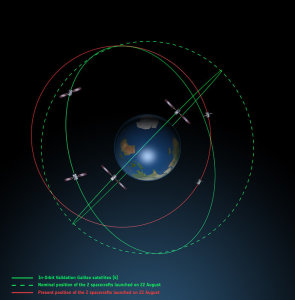The fifth Galileo navigation satellite, one of the two left in an incorrect orbit when being launched this summer, has begun maneuvering into a higher orbit where the satellite’s navigation payload and all other systems will be checked out.
The Galileo FOC-1 and 2 satellites launched together on a Soyuz rocket on August 22, instead of reaching a circular orbit at 23,222 Kilometers inclined 55.04 degrees, were released into an anomalous orbit of 13,710 by 25,900 Kilometers with a lower inclination of 49.69 degrees.
After launch, the two FOC satellites partially deployed their solar arrays, requiring additional procedures from teams on the ground to develop commands to fully extend each satellite’s two solar arrays. With the two satellites in a stable condition, teams began assessments of the different options that were available since the limited propellant supply of the spacecraft would not allow them to fully correct their orbit.
Using their 1-Newton thrusters fed from a 73-Kilogram hydrazine supply, the satellites can raise their perigee altitude by about 4,000 Kilometers, allowing them to enter an orbit that is not intersecting the Van Allen radiation belts surrounding Earth. Due to increased radiation in the Van Allen Belts, there was concern that the operational life of the various electronics aboard the satellites may be reduced in the event of prolonged exposure.
It was determined that the best course of action would be to dedicate most of the vehicle’s propellant to raising the perigee (lowest point) of the orbit from 13,713 to 17,339 Kilometers. Once in that orbit, the satellite would be out of the most intense areas of radiation. Although the two spacecraft will not reach their nominal working orbit, “the new orbit will fly over the same location every 20 days,” said Daniel Navarro-Reyes, ESA Galileo mission analyst. “The standard Galileo repeat pattern is every 10 days, so achieving this will synchronize the ground track with the rest of the Galileo satellites.”
The revised orbit will also reduce the variation in signal levels, limit the Doppler shift and increase the satellite visibility.
“For the satellite, reducing its radiation exposure in the Van Allen radiation belts will protect it from further exposure to charged particles. The orbit will also allow Galileo’s Earth Sensor to hold a stable direction for the satellite’s main antenna to point at Earth. Right now, when the satellite dips to its lowest point, Earth appears so large that the sensor is unusable. The satellite relies on gyroscopes alone, degrading its attitude precision” Navarro-Reyes said.
The first satellite was transitioned from a sun-pointing safe mode to an operational Earth-pointing attitude on November 3 and initiated perigee-raising maneuvers several days later. Over the course of November, up to 15 such maneuvers will be performed.
When the first satellite arrives in its new target orbit, ground controllers will begin the process of checking out all its core systems before activating the navigation payload for a detailed set of checkouts and characterization in the modified orbit. The navigation payloads remained deactivated in the lower orbit to avoid radiation-related upsets and limit the chances of permanent damage.
Maneuvers of the second satellite will be started once the first satellite has been fully checked and the capabilities of the navigation payload from the new orbit are well characterized. It is anticipated that the two satellites, with some changes to ground systems and position cataloging, will be able to provide service as part of the Galileo constellation at least as part of the initial stages of deployment.


Very informative post! It’s so fascinating to learn about the space program and how technology is changing to improve it even more. Thanks so much for sharing this!
Thanks, Valerie, for your encouragement message 🙂